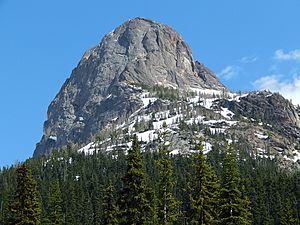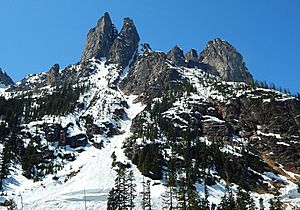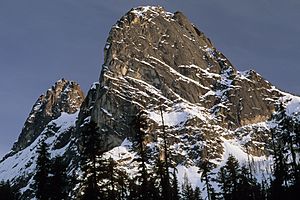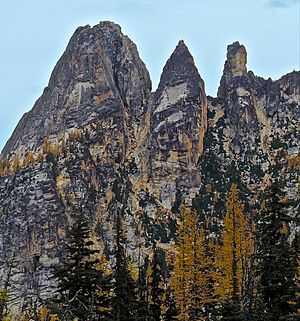Liberty Bell Mountain facts for kids
Liberty Bell Mountain is a cool peak located in the North Cascades mountain range. It's about one mile south of Washington Pass in the state of Washington, USA. This mountain is the most northern part of a group of peaks called the Liberty Bell Group. This group also includes Concord Tower, Lexington Tower, North Early Winters Spire, and South Early Winters Spire.
Even though it's not the tallest mountain, Liberty Bell Mountain is very famous in Washington. It's well-known for its amazing rock climbing. Thanks to the North Cascades Highway, it's easy to get to, making it a popular spot for climbers. The mountain has excellent granite rock, which makes for challenging and fun climbs. People often visit on weekends to try out the many climbing routes. These routes range from easier climbs (like 5.6 class) to very difficult ones (like 5.12a class).
Quick facts for kids Liberty Bell Mountain |
|
|---|---|
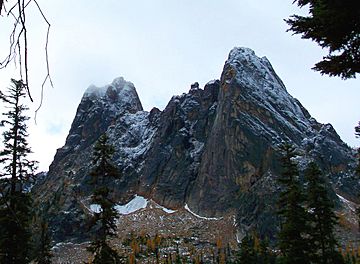
Liberty Bell Mountain above Washington Pass
|
|
| Highest point | |
| Elevation | 7,720+ ft (2,350+ m) NGVD 29 |
| Prominence | 200 ft (60 m) |
| Geography | |
| Location | near Washington Pass, Chelan / Okanogan counties, Washington, U.S. |
| Parent range | North Cascades |
| Topo map | USGS Washington Pass |
| Type of rock | Granite |
| Climbing | |
| First ascent | 1946, Fred Beckey, Jerry O'Neil, and Charles Welsh |
| Easiest route | class 5.6 The Beckey Route |
Rock Climbing Adventures
Liberty Bell Mountain has 18 different climbing routes, each with its own name. One very famous route is called Liberty Crack. It's even featured in a well-known climbing book called Fifty Classic Climbs of North America.
The very first time someone successfully climbed Liberty Bell Mountain was on September 27, 1946. Three climbers named Fred Beckey, Jerry O’Neil, and Charles Welsh made the first ascent. They climbed what is now known as the Beckey route.
Here are some of the exciting climbing routes on Liberty Bell Mountain:
- Beckey Route (SW Face) - class 5.6 - 3 pitches
- Freedom or Death - class 5.12a - 4 pitches
- A Slave To Liberty - class 5.13- - 11 pitches
- NW Face - class 5.9 - 5 pitches
- Serpentine Crack - class 5.11 - 4 pitches
- The Girl Next Door - class 5.9- - 3 pitches
- Rapple Grapple - class 5.8 - 4 pitches
- Overexposure - class 5.8 - 2 pitches
- Freedom Rider - class 5.10d - 14 pitches
- Liberty Crack - class 5.11a - 12 pitches
- Liberty Crack Free - class 5.13b - 12 pitches
- Thin Red Line (Free Version) - class 5.12 - 11 pitches
- Liberty and Injustice for All - class 5.12 - 5 pitches
- The Independence Route - class 5.12a - 12 pitches
- NW Face Var. (Remsberg Variation) - class 5.10d - 5 pitches
- Live Free or Die! - class 5.11c - 11 pitches
Mountain Weather
The weather around Liberty Bell Mountain is very interesting! Weather systems from the Pacific Ocean often move towards the Cascade Range. As these weather fronts hit the tall Cascade Mountains, they are forced to rise. This causes them to drop a lot of rain or snow onto the mountains.
Because of this, the western side of the North Cascades gets a lot of precipitation, especially snow in winter. Winters are usually cloudy. However, during the summer, high-pressure systems over the Pacific Ocean often bring clear skies.
The snow here tends to be wet and heavy. This can lead to a high risk of avalanches. In fact, the North Cascades Highway has one of the highest numbers of avalanche paths per mile in the United States! The best months to visit or climb Liberty Bell Mountain are usually July, August, and September, when the weather is most favorable.
How the Mountains Formed
The North Cascades mountains have a very rugged and dramatic landscape. You can see sharp peaks, long ridges, and deep valleys carved by glaciers. All these different shapes and heights were created by geological events that happened millions of years ago. These events also led to the different climates you find across the Cascade Range.
The Cascade Mountains started forming millions of years ago, during a time called the late Eocene Epoch. This happened because the North American Plate (a huge piece of Earth's crust) was slowly moving over the Pacific Plate. This movement caused a lot of volcanic activity.
Also, small pieces of Earth's crust, called terranes, came together to form the North Cascades about 50 million years ago. Like many peaks in the Washington Pass area, Liberty Bell Mountain is made from a type of rock called granite. This granite comes from a large body of rock known as the Golden Horn batholith.
During the Pleistocene period, which was over two million years ago, huge sheets of ice called glaciers moved across the land. They advanced and then melted back many times. As they moved, they scraped and shaped the landscape, leaving behind rock debris. The "U"-shaped valleys you see today were formed by these glaciers. The combination of land being pushed up (called uplift) and cracks forming in the Earth (called faulting), along with the glaciers, created the tall peaks and deep valleys of the North Cascades.
- Weather forecast: Liberty Bell Mountain
 |
Cutthroat Benchmark/Peak 7160 | Hinkhouse Peak | Big Kangaroo |
|
|||
| Cutthroat Peak | Kangaroo Ridge | ||||||
| Whistler Mountain (Washington) | Half Moon/Wallaby Peak | ||||||
| Early Winters Spires | Blue Lake Peak/Cornice Peak (Cascades) | Pica Peak/Copper Benchmark |


